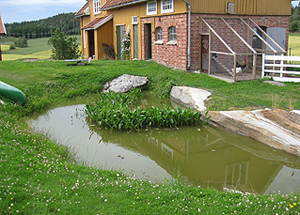 Small farm pond at Oddestad vestre (Hobøl, Øf), first surveyed in 2003 and then re-analysed in 2009 (Photo: A. Edvardsen).
Small farm pond at Oddestad vestre (Hobøl, Øf), first surveyed in 2003 and then re-analysed in 2009 (Photo: A. Edvardsen).
Agricultural landscapes are landscapes of change, formed by continuous human influence over generations. During the last decades a polarisation has taken place within the agricultural landscape; already intensively managed land is subjected to increasingly intensified use while more extensively managed land is abandoned. This process may lead to a less complex landscape structure, and it has been assumed that this simplification may reduce biodiversity at all levels (ecosystem, community, species, population and genes). These biological changes have wide-ranging consequences, the nature and extent of which remain largely unknown.
Vascular plants constitute an important part of landscape biodiversity and many of the typically occurring species are culturally dependent. In more intensively managed landscapes small patches of remnant vegetation (e.g. farm ponds, woodlots, mid-field islets, former hay-meadows or grazing-land) hold a key position by serving as the only hospitable habitat islands for a wide range of species. Linear landscape elements such as ditches, hedges, field margins and road verges may also serve as habitats in their own right and also link habitat patches together. Consequently, knowing the variation in species composition and species richness in modern agricultural landscapes is important for appropriate biodiversity management. Moreover, habitat specificity analysis provides a tool for partitioning landscape species diversity on landscape elements by separating patches with many rare specialist species from patches with the same number of species, all of which are common generalists and thus provide information of relevance to conservation goals at regional and national levels.
We aim at addressing the spatial distribution and dynamics of vascular plant species in modern agricultural landscapes by analysing species and environmental data from 2201 patch elements (3Q), and in particular by studying vegetation patterns in farm ponds and present and former semi-natural grasslands (Edvardsen et al. 2010). To acquire a better basis for assessment of rare species, mapping and monitoring of red-listed species is necessary. Predictive habitat distribution models, which relate the geographical distribution of a species to its environment, have become a promising tool in ecology. By using spatial predictions, sampling efficiency of rare species may be increased and the findings of new occurrences of rare species may be simplified. We have explored the applied use of niche models by making spatial predictions of a red-listed species, Scorzonera humilis, in Norway (Edvardsen et al. 2010).
Related publications
- Edvardsen, A., Økland, R.H., 2006a. Variation i plant species richness in and adjacent to 64 ponds in SE Norwegian agricultural landscapes. Aquatic Botany 85: 79–91.
- Edvardsen, A., Økland, R.H., 2006b. Variation i plant species composition in and adjacent to 64 ponds in SE Norwegian agricultural landscapes. Aquatic Botany 85: 92–102.
- Bratli, H., Økland, T., Økland, R.H., Dramstad, W.E., Elven, R., Engan, G., Fjellstad, W., Heegaard, E., Pedersen, O., Solstad, H. 2006. Patterns of variation in vascular plant species richness and composition in SE Norwegian agricultural landscapes. Agricult Ecosyst Environm 114: 270–286.
- Økland, R.H., Bratli, H., Dramstad, W.E., Edvardsen, A., Engan, G., Fjellstad, W., Heegaard, E., Pedersen, O., Solstad, H. 2006. Scale-dependent importance of environment, land use and landscape structure for species richness and composition of SE Norwegian modern agricultural landscapes. Landscape Ecology 21: 969–987.
- Halvorsen, R., Edvardsen, A. 2009. The concept of habitat specificity revisited. Landscape Ecology 24: 851–861.